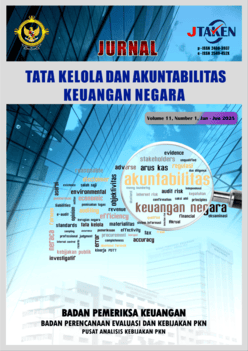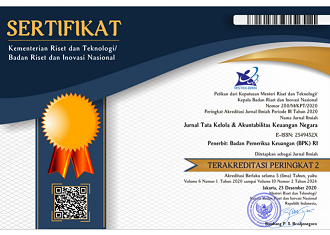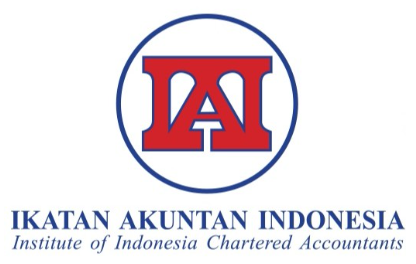Developing operational risk-level assessment for selecting auditable units: Factor analysis and analytic hierarchy process approach
DOI:
https://doi.org/10.28986/jtaken.v11i1.1701Keywords:
Risk Level, Auditable Unit, Analytic Hierarchy Process, Factor Analysis, Operational RiskAbstract
This study introduces a new method for calculating operational risk levels in selecting audit units at Statistics Indonesia (BPS). The key novelty of this study lies in its two-level assessment framework, which systematically compares different risk calculation methods to determine the most effective approach for operational risk evaluation. Using exploratory factor analysis, the study identifies four key operational risk factors: operational costs, internal control, investment and guarantees, also financial performance. The analytic hierarchy process (AHP) is then applied to systematically assign weight scores to these factors and their corresponding subcriteria based on expert judgment. Integrating these approaches results in a more structured, comprehensive, and accurate risk assessment model. Compared to the previous method, this new method exhibits a narrower but more optimal risk-level range, a slightly higher average operational risk level, and fewer instances of underestimation or overestimation. This new method enhances the precision of risk assessment in selecting BPS audit units, enabling the internal audit team to allocate resources more effectively by prioritizing high-risk work units. Consequently, the overall efficiency and effectiveness of BPS's internal audit process improved.
References
AAIPI. (2018). Pedoman perencanaan audit berbasis risiko auditor intern pemerintah Indonesia. Asosiasi Auditor Intern Pemerintah Indonesia.
Almasria, N. A. (2022). Factors affecting the quality of audit process “The external auditors’ perceptions.” The International Journal of Accounting and Business Society, 30(1), 107-148. https://doi.org/10.21776/ijabs.2022.30.1.539
Arens, A. A., Elder, R. J., & Beasley, M. S. (2014). Auditing and assurance service: An integrated approach. Pearson Education Inc.
Aven, T. (2016). Risk assessment and risk management: Review of recent advances on their foundation. European Journal of Operational Research, 253(1), 1-13. https://doi.org/10.1016/j.ejor.2015.12.023
Bakri, M. R., & Rahardyan, T. M. (2022). Pengaruh opini, temuan dan karakteristik daerah terhadap kinerja keuangan Provinsi Jambi. Jurnal Akuntansi, 10(1), 1-14. https://doi.org/10.26460/ja.v11i1.2990
Bhushan, N., & Rai, K. (2004). Strategic decision making: Applying the analytic hierarchy process. Springer.
Bognár, F., & Benedek, P. (2022). A novel AHP-PRISM risk assessment method—An empirical case study in a nuclear power plant. Sustainability, 14(17), 11023. https://doi.org/10.3390/su141711023
BPS. (2022). Program Kerja Pengawasan Tahunan (PKPT) inspektorat utama tahun 2022.
Cerić, A., & Ivić, I. (2023). Application of analytic hierarchy process (AHP) in earthquake risk assessment. Proceedings of the 2nd Croatian Conference on Earthquake Engineering - 2CroCEE (pp. 964-974). https://doi.org/10.5592/CO/2CroCEE.2023.133
Defitri, S. Y. (2020). Pengaruh belanja modal dan belanja pegawai terhadap tingkat kemandirian keuangan daerah. Fokus Bisnis: Media Pengkajian Manajemen Dan Akuntansi, 19(2), 107-119. https://doi.org/10.32639/fokusbisnis.v19i2.476
Demirhan, A., Oktay, S., & Atasoy, T. (2018). Audit firm selection using an analytic hierarchy process and an application. In H. Kapucu & C. Akar (Eds.), Changing organizations: From the psychological & technological perspectives. IJOPEC Publication.
Dey, P. K. (2003). Analytic hierarchy process analyzes risk of operating cross-country petroleum pipelines in India. Natural Hazards Review, 4(4), 213–221. https://doi.org/10.1061/(asce)1527-6988(2003)4:4(213)
Ditasari, R. A., & Sudrajat, M. A. (2020). Pengaruh opini audit dan temuan audit BPK terhadap kinerja pemerintah daerah pada kabupaten/kota di provinsi jawa timur. Inventory: Jurnal Akuntansi, 4(2), 104. https://doi.org/10.25273/inventory.v4i2.7668
Ebnöther, S., Vanini, P., Mcneil, A., & Antolinez-Fehr, P. (2003). Modelling operational risk. Journal of Risk, 5(1), 1-16. https://doi.org/10.2139/ssrn.293179
Eilifsen, A., & Messier, W. F. (2015). Materiality guidance of the major public accounting firms. Auditing: A Journal of Practice & Theory, 34(2), 3-26. https://doi.org/10.2308/ajpt-50882
Felix, W. L., Gramling, A. A., & Maletta, M. J. (2001). The contribution of internal audit as a determinant of external audit fees and factors influencing this contribution. Journal of Accounting Research, 39(3), 513-534. https://www.jstor.org/stable/2672973
Fresiliasari, O. (2023). Pengaruh sistem pengendalian intern pemerintah dan kompetensi aparatur pemerintah desa terhadap pencegahan fraud dalam pengelolaan dana desa dengan akuntabilitas sebagai variabel intervening. Jurnal Akuntansi Dan Pajak, 23(2), 1-10. http://jurnal.stie-aas.ac.id/index.php/jap
Furqan, A. C., Wardhani, R., Martani, D., & Setyaningrum, D. (2020). The effect of audit findings and audit recommendation follow-up on the financial report and public service quality in Indonesia. International Journal of Public Sector Management, 33(5), 535-559. https://doi.org/10.1108/ijpsm-06-2019-0173
Hair, J. F., Black, J., Babin, W. C., Anderson, B. J., & R. E. (2018). Multivariate data analysis. Cengage Learning.
Hariadi, B. W. (2020). Analisis perencanaan audit intern berbasis risiko pada Inspektorat Utama Badan Pusat Statistik. ABIS: Accounting and Business Information Systems Journal, 8(1). https://doi.org/10.22146/abis.v8i1.58883
Hubbard, D. W. (2020). The failure of risk management. Wiley.
Institute of Internal Auditors. (2009). IIA position paper: The role of internal auditing in enterprise-wide risk management. The Institute of Internal Auditors. https://na.theiia.org/standards-guidance/Public Documents/PPTheRoleofInternalAuditinginEnterpriseRiskManagement.pdf
Johnson, R. A., & Wichern, D. W. (2005). Multivariate analysis. In: Encyclopedia of statistical sciences. Wiley.
Kustiawan, M. (2017). Pengaruh pengendalian intern dan tindak lanjut temuan audit terhadap kualitas laporan keuangan yang berimplikasi terhadap pencegahan fraud. Jurnal Akuntansi, 20(3), 345-362. https://doi.org/10.24912/ja.v20i3.2
Kuvat, Ö., & Kılıç, B. İ. (2020). The evaluation of the criteria for the selection and change of the independent audit firm using the AHP method. Contemporary Studies in Economic and Financial Analysis, 102, 189-202. https://doi.org/10.1108/s1569-375920200000102015
Ladewi, Y., Nurhayati, N., Mizan, M., & Janatul, R. (2020). Pengaruh penerapan sistem pengandalian internal pemerintah terhadap pencegahan kecurangan. Kajian Akuntansi, 21(1), 99-107. https://doi.org/10.29313/ka.v21i1.5835
Latief, H., Asri, S., & Santosa, A. (2023). Akuntabilitas kinerja instansi pemerintah pada pemerintah Kabupaten Paser. Journal Publicuho, 5(4), 1367-1376. Https://Doi.Org/10.35817/Publicuho.V5i4.83
Lawrence, A., Minutti-Meza, M., & Vyas, D. (2018). Is operational control risk informative of financial reporting deficiencies?. Auditing, 37(1), 139-165. https://doi.org/10.2308/ajpt-51784
Le, T. T., & Nguyen, T. M. A. (2020). The adoption of risk-based audit approach in the independent audit firms: A study of a case of Vietnam. The Journal of Asian Finance, Economics and Business, 7(2), 89-97. https://doi.org/10.13106/jafeb.2020.vol7.no2.89
Lee, R. M. (1991). Auditing as pattern recognition: Automated analysis of documentary procedures. http://dx.doi.org/10.2139/ssrn.2025707
Lukito, P. K. (2014). Membumikan transparansi dan akuntabilitas kinerja sektor publik: tantangan berdemokrasi ke depan. Grasindo.
Manfa, A. G. (2022). Pengaruh audit internal dan pengendalian internal terhadap pencegahan kecurangan (studi empiris amal usaha Muhammadiyah tingkat kota Pekanbaru). ECOUNTBIS: Economics, Accounting and Business Journal, 2(3), 521–530. https://jom.umri.ac.id/index.php/ecountbis/article/view/113
Masni, E. P., & Sari, V. F. (2023). Pengaruh akuntabilitas, kesesuaian kompensasi, pengendalian internal, dan budaya organisasi terhadap kecurangan dana desa. Jurnal Eksplorasi Akuntansi, 5(1), 263-277. https://doi.org/10.24036/jea.v5i1.729
Mihret, D. G., & Yismaw, A. W. (2007). Internal audit effectiveness: An Ethiopian public sector case study. Managerial Auditing Journal, 22(5), 470-484. https://doi.org/10.1108/02686900710750757
Moeller, R. R. (2009). Brink's modern internal auditing a common body of knowledge (7th ed.). John Wiley & Sons.
Muanley, Y. Y., Son, A. L., Mada, G. S., & Dethan, N. K. F. (2022). Analisis sensitivitas dalam metode analytic hierarchy process dan pengaruhnya terhadap urutan prioritas pada pemilihan smartphone android. VARIANSI: Journal of Statistics and Its Application on Teaching and Research, 4(3), 173–190. https://doi.org/10.35580/variansiunm32
Munawir, M., & Meutia, R. (2021). Faktor-faktor yang mempengaruhi kinerja keuangan: Studi kasus kabupaten/kota di aceh. Jurnal Ilmiah Mahasiswa Ekonomi Akuntansi (JIMEKA), 6(4), 1. https://doi.org/10.24815/jimeka.v6i4.19751
Purwanto, P., Hartoyo, D. S., & S. (2015). Net neutrality in India. International Journal of Science and Research (IJSR), 4(12), 217-222. https://doi.org/10.21275/v4i12.nov151590
Pusdiklatwas BPKP. (2014). Perencanaan penugasan audit intern. BPKP.
Puslitbangwas BPKP. (2020). Pedoman Praktis Membangun Indeks Komposit (Issue July). BPKP.
Qowi, R., & Prabowo, T. J. W. (2017). Pengaruh karakteristik pemerintah daerah dan temuan pemeriksaan BPK terhadap kinerja pemerintah daerah kabupaten/kota di Indonesia tahun anggaran 2012. Diponegoro Journal of Accounting, 6(1), 1-13. http://ejournal-s1.undip.ac.id/index.php/accounting
Rahim, A., & Saputra, H. (2018). Exploratory factor analysis (EFA) pada penyerapan anggaran pendapatan dan belanja negara (APBN) tahun 2017 di Provinsi Sumatera Barat. Indonesian Treasury Review: Jurnal Perbendaharaan Keuangan Negara Dan Kebijakan Publik, 3(3), 236-254. https://doi.org/10.33105/itrev.v3i3.72
Rasyid, Y., Suci, R. G., & Putri, A. M. (2022). Pengaruh opini audit dan temuan audit BPK terhadap kinerja pemerintah daerah kabupaten/kota di Provinsi Riau. PROMOSI (Jurnal Pendidikan Ekonomi), 10(2), 80-93. https://doi.org/10.24127/pro.v10i2.6589
Ristanović, V., Primorac, D., & Mikić, M. (2023). Application of multi-criteria assessment in banking risk management. Zagreb International Review of Economics and Business, 26(1), 97-117. https://doi.org/10.2478/zireb-2023-0005
Rumihin, R., Ahuluheluw, N., & Leiwakabessy, T. F. F. (2021). Pengaruh karakteristik pemerintah daerah terhadap opini audit atas laporan keuangan pada kab/kota di Provinsi Maluku Tahun 2016-2018. Prosiding Conference on Economic and Business Innovation (CEBI), 1(1), 990–1002. Retrieved from https://jurnal.widyagama.ac.id/index.php/cebi/article/view/167
Russo, R. D. F. S. M., & Camanho, R. (2015). Criteria in AHP: A systematic review of literature. Procedia Computer Science, 55, 1123-1132. https://doi.org/10.1016/j.procs.2015.07.081
Saaty, T. L. (1980). The analytic hierarchy process. Hill International Book Company.
Saleh, I., & Rahadian, Y. (2023). Akar Masalah Tidak Tercapainya Opini WTP: Studi Kasus di Pemerintah Daerah XX. Indonesian Treasury Review: Jurnal Perbendaharaan, Keuangan Negara Dan Kebijakan Publik, 8(2), 109-124. https://doi.org/10.33105/itrev.v8i2.547
Saraswati, S. R., & Triyanto, D. N. (2020). Pengaruh temuan audit, transparansi, dan akuntabilitas terhadap tingkat korupsi (Studi pada Pemerintah Daerah Jawa Timur tahun 2015-2018). E-proceeding of Management, 7(1), 1000-1007.
Setyaningrum, D. (2017). The Direct and mediating effects of an auditor's quality and the legislative's oversight on the follow-up of audit recommendation and audit opinion. International Journal of Economic Research, 14(13), 269-292.
Siregar, M. I., & Rudiansyah, J. (2019). Pengaruh jumlah temuan audit terhadap opini audit kabupaten/kota se sumatera. Jurnal Ecoment Global, 4(1), 101-124. https://doi.org/10.35908/jeg.v4i1.576
Sudarmono, S., & Tobing, A. N. L. (2022). Designing a risk-based internal audit plan in the internal auditor division (A case study in PT. XY). Budapest International Research and Critics Institute-Journal (BIRCI-Journal), 5(1), 1528-1542.
Sueyoshi, T., Shang, J., & Chiang, W. C. (2009). A decision support framework for internal audit prioritization in a rental car company: A combined use between DEA and AHP. European Journal of Operational Research, 199(1), 219-231. https://doi.org/10.1016/j.ejor.2008.11.010
Sum, R. M. (2015, September 29-October 1). Risk prioritization using the analytic hierarchy process [Paper presentation]. The 2nd Innovation and Analytics Conference & Exhibition, Kedah, Malaysia. https://doi.org/10.1063/1.4937047
Valahzaghard, M. K., & Ferdousnejhad, M. (2013). Ranking insurance firms using AHP and Factor Analysis. Management Science Letters, 3, 937-942. https://doi.org/10.5267/j.msl.2013.01.027
van Asseldonk, M. A. P. M., & Velthuis, A. G. J. (2014). Risk-based audit selection of dairy farms. Journal of Dairy Science, 97(2), 592-597. https://doi.org/10.3168/jds.2013-6604
Wahyuningsih, T., Ristono, A., & Muhsin, A. (2022). The application of factor analysis (FA) in evaluating supplier selection criteria in PT. Wijaya Karya Beton Tbk and ranking suppliers using the integration of analytical hierarchy process (AHP) and adaptive ratio assessment (ARAS). Technium: Romanian Journal of Applied Sciences and Technology, 4(6), 11-17. https://doi.org/10.47577/technium.v4i6.6814
Wang, L. (2021). A multi-level fuzzy comprehensive assessment for supply chain risks. Journal of Intelligent & Fuzzy Systems, 41(4), 4947-4954. https://doi.org/10.3233/jifs-189981
Wang, X., Ferreira, F. A. F., & Yan, P. (2023). A multi-objective optimization approach for integrated risk-based internal audit planning. Annals of Operations Research, 1(1), 30. https://doi.org/10.1007/s10479-023-05228-2
Wang, X., Zhao, T., & Chang, C.-T. (2021). An integrated FAHP-MCGP approach to project selection and resource allocation in risk-based internal audit planning: A case study. Computers & Industrial Engineering, 152, 107012. https://doi.org/10.1016/j.cie.2020.107012
Widodo, O. P., & Sudarno. (2017). Pengaruh temuan kelemahan sistem pengendalian intern dan temuan ketidakpatuhan terhadap ketentuan peraturan perundang-undangan. Diponegoro Journal of Accounting, 6(1), 1-9.
Yalisman, F. (2021). Analisis prioritas monitoring dan evaluasi pelaksanaan anggaran kementerian negara/lembaga berdasarkan model analityc hierarchy process. Jurnal Ilmiah Mahasiswa FEB Universitas Brawijaya, 7(2), 18.
Yamin, S., & Kurniawan, H. (2011). SPSS complete: Teknik analisis statistik terlengkap dengan software SPSS. Salemba Infotek.
Zemtsov, T. A., & Sorokin, M. A. (2022). Risk assessment in risk-oriented audits by internal audit units. Vestnik Tomskogo Gosudarstvennogo Universiteta. Ekonomika, 57, 129-144. https://doi.org/10.17223/19988648/57/9
Downloads
Submitted
Accepted
Published
How to Cite
Issue
Section
License
Copyright (c) 2025 Jurnal Tata Kelola dan Akuntabilitas Keuangan Negara

This work is licensed under a Creative Commons Attribution-ShareAlike 4.0 International License.

Jurnal Tata Kelola dan Akuntabilitas Keuangan Negara is licensed under
a Creative Commons Attribution-ShareAlike 4.0 International License





















